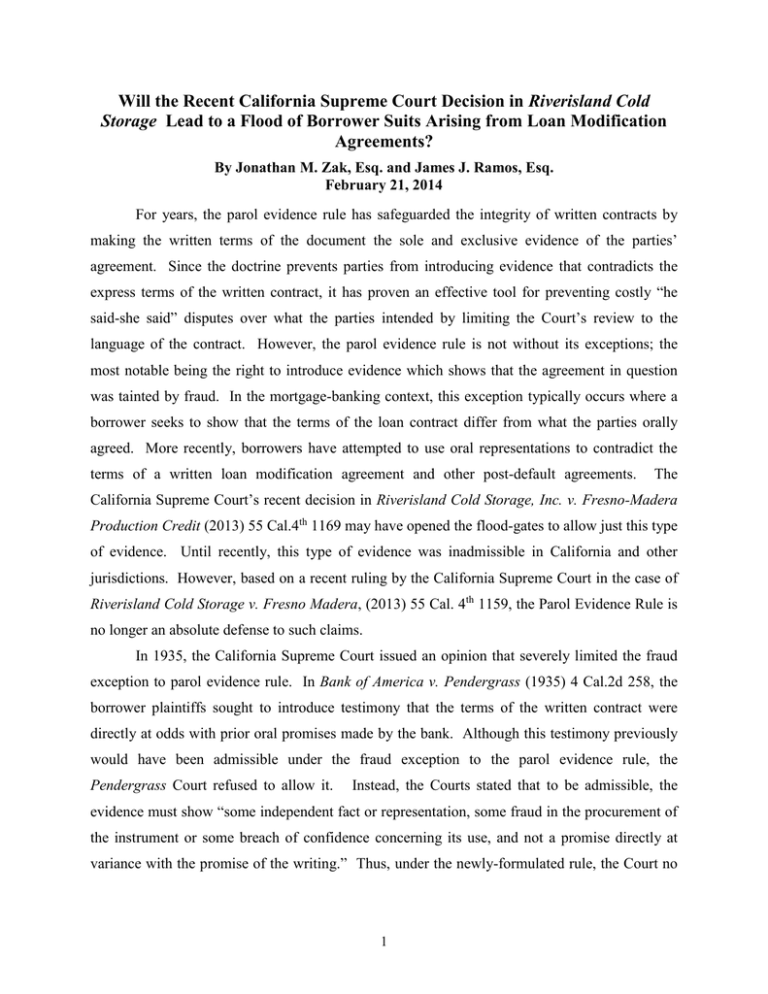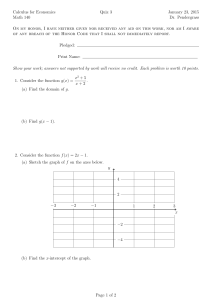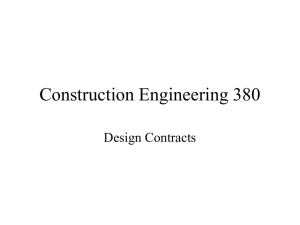Will the Recent California Supreme Court Decision in Riverisland
advertisement

Will the Recent California Supreme Court Decision in Riverisland Cold Storage Lead to a Flood of Borrower Suits Arising from Loan Modification Agreements? By Jonathan M. Zak, Esq. and James J. Ramos, Esq. February 21, 2014 For years, the parol evidence rule has safeguarded the integrity of written contracts by making the written terms of the document the sole and exclusive evidence of the parties’ agreement. Since the doctrine prevents parties from introducing evidence that contradicts the express terms of the written contract, it has proven an effective tool for preventing costly “he said-she said” disputes over what the parties intended by limiting the Court’s review to the language of the contract. However, the parol evidence rule is not without its exceptions; the most notable being the right to introduce evidence which shows that the agreement in question was tainted by fraud. In the mortgage-banking context, this exception typically occurs where a borrower seeks to show that the terms of the loan contract differ from what the parties orally agreed. More recently, borrowers have attempted to use oral representations to contradict the terms of a written loan modification agreement and other post-default agreements. The California Supreme Court’s recent decision in Riverisland Cold Storage, Inc. v. Fresno-Madera Production Credit (2013) 55 Cal.4th 1169 may have opened the flood-gates to allow just this type of evidence. Until recently, this type of evidence was inadmissible in California and other jurisdictions. However, based on a recent ruling by the California Supreme Court in the case of Riverisland Cold Storage v. Fresno Madera, (2013) 55 Cal. 4th 1159, the Parol Evidence Rule is no longer an absolute defense to such claims. In 1935, the California Supreme Court issued an opinion that severely limited the fraud exception to parol evidence rule. In Bank of America v. Pendergrass (1935) 4 Cal.2d 258, the borrower plaintiffs sought to introduce testimony that the terms of the written contract were directly at odds with prior oral promises made by the bank. Although this testimony previously would have been admissible under the fraud exception to the parol evidence rule, the Pendergrass Court refused to allow it. Instead, the Courts stated that to be admissible, the evidence must show “some independent fact or representation, some fraud in the procurement of the instrument or some breach of confidence concerning its use, and not a promise directly at variance with the promise of the writing.” Thus, under the newly-formulated rule, the Court no 1 longer allowed evidence of an alleged false promise that “contradicted” the terms of a subsequently written agreement, even if the evidence sounded in fraud. Given that its holding was a departure from the existing principle that a contract can always be invalidated by a showing of fraud, it is not surprising that the Pendergrass decision was criticized in its time and largely ignored for the next 50 years. However, in the late 1980’s, there was a sudden rash of multi-million dollar judgments against lenders arising out of alleged fraudulently induced loans. Perhaps in response, the Court in Price v. Wells Fargo Bank (1989) 213 Cal.App.3d 465, pulled the Pendergrass decision out of mothballs to reverse a massive jury verdict in favor of a Central California rancher who claimed the bank had lied to him about the terms of his loan. The Price Court held that the parol evidence rule prevented the rancher from introducing evidence of false statements allegedly made by the bank which tended to contradict the terms of the signed written agreement. After noting the parol evidence rule was intended to make contracts more certain by preventing subsequent allegations that the parties had orally agreed to something different, the Price court refused to let the jury hear plaintiff’s testimony of the bank’s alleged oral promissory fraud. After Price, bank counsel immediately recognized the value of the parol evidence rule as a quick and expedient defense to many lender liability claims. This defense was used with great success for the next 25 years, as lenders invoked the rule to bar evidence of purportedly false statements made prior to execution of the loan agreement. But, the reappearance of Pendergrass did not last. In the wake of the subprime real estate crisis of the late 2000’s, there was a growing concern that the parol evidence defense was being used by lenders to cover up their own wrongdoing, particularly in connection with loan modification negotiations. This sentiment culminated in January of 2013, when the California Supreme Court overturned Pendergrass and its progeny in the decision of Riverisland Cold Storage v. FresnoMadera. In Riverisland, the parties entered into a loan modification agreement, whereby the lender allegedly agreed to delay foreclosure if the borrowers pledged eight separate parcels of land as additional security. After the borrowers defaulted, the lender initiated foreclosure. In response, the borrowers filed suit to rescind the agreement on the grounds of fraud. Specifically, the borrowers sought to introduce oral evidence that, just two weeks before the contract was signed, the lender promised that only two parcels of land would be required as additional 2 security. In defense, the lender successfully moved to exclude the testimony as inadmissible parole evidence and judgment was entered in its favor. However, the Supreme Court reversed. In doing so, it struck down its ruling in Pendergrass, calling it a “poorly reasoned opinion”. Noting that “it was never intended that the parol evidence rule should be used as a shield to prevent the proof of fraud”, the Supreme Court found the ruling in Pendergrass to be “plainly out of step with established California law” and little more than a legal “aberration”. In doing so, the Supreme Court overturned Pendergrass based on “the fundamental principle that fraud undermines the essential validity of the parties’ agreement.” Thus, borrowers may once again present evidence of fraud to circumvent the parol evidence rule, regardless of whether such evidence is consistent with the terms of the contract. At a micro-level, this ruling primarily presents an evidentiary issue. Whereas previously all evidence of oral negotiations that contradicted the agreement was inadmissible, now such evidence is allowed to show that a party was fraudulently induced to enter into the contract. From a defense standpoint, lenders can anticipate a growing number of cases where borrowers claim they were lied to about the terms of a loan modification, forbearance agreement (which is exactly the type of frivolous claims that the courts in Pendergrass and Price sought to prevent). Because such claims create triable issues of fact, they will not easily be disposed of on demurrer or summary judgment. Lenders and loan servicers will now be unable to defend these cases quickly and cheaply. Rather, they will now be forced to wade through the costly stages of discovery, trial, and appeal just to achieve a resolution. Alternatively, they will be forced to settle the matter from an unfavorable bargaining position. Thus, this new limitation on the parol evidence rule will have very real economic consequences for lenders and loan servicers. Going forward, lenders and servicers may wish to consult with their counsel on ways to preemptively combat the flood of promissory fraud claims that will soon follow. For instance, some loan servicers require that the borrower execute a handwritten statement attesting that the borrower did not rely on any oral representations in making the decision to enter into any postdefault agreements. Lenders could do the same at loan origination. In the technological age that we live in, another option is to record and preserve communications with the borrowers to refute any later allegations of false promises made prior to signing the loan modification or other loan documents. 3 Unfortunately, none of the above precautions will provide a complete defense to a claim of fraud in the inducement. However, these and other measures will leave the servicer and lender in a better position to rebut and defend against the flurry of fraud claims resulting from the Supreme Court’s decision in Riverisland. 4





